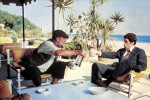When Robert Altman was at the peak of his filmmaking during the days of “Nashville” and “McCabe & Mrs. Miller,” he was one of the greatest directors of his day. Many of his films have been proclaimed masterpieces of the eras in which they were made. His famed and influential stylistic techniques – the overlapping dialogue, the long takes, the zooms – are still being studied, analyzed and appropriated.
Over the next three months at the Hammer Museum’s Billy Wilder Theater, the UCLA Film and Television Archive will be presenting a series covering Altman’s illustrious career, from the most opulent gems to his most disastrous failures.
Like individual pieces of a much larger mosaic, the various movies, early short films, music videos (“Scopitones”), filmed stage plays and television dramas that are featured in this meticulously constructed retrospective arrange themselves to create a portrait of an American visionary.
Altman may have occasionally made bad films, but they were still interesting films in their own right. Even his bad movies usually had a certain charm, a kind of daring inventiveness that separated them from the works of most of his contemporaries.
For this week’s column, I will highlight two films from the series that I feel are unfairly ignored by the film community at large. However, I urge anyone reading to see the other films being shown, from the brilliant “MASH” to the Agatha Christie-like “Gosford Park.”
“The Long Goodbye” (1973)
May 29
In this adaption of a famous novel by Raymond Chandler, the king of crime fiction, famed private eye Philip Marlowe (Elliott Gould), looks for an old friend who may or may not have killed his wife, and who may or may not be dead himself.
Outside of the main plot, there are also hippies, an alcoholic writer living in Malibu, a mysterious blonde and a great title song that plays throughout the film in various arrangements (as a jazz standard, supermarket music, etc.).
https://www.youtube.com/watch?v=GeNyD9UFXHs
Altman opted to replace the Old Hollywood setting of the novel with the Los Angeles of the 1970s, making it one of the more interesting adaptions of its era, perhaps because the film was written by Leigh Brackett, who also penned the screenplay for the 1946 Marlowe adaptation “The Big Sleep.”
Gould’s Marlowe retains many elements the character is known for, such as his sardonic wit – while being interrogated by police, he quips, “This is where I say, ‘What’s all this about?’ and you say, ‘We ask the questions.'” However, the environment around Marlowe has changed completely. His hard-boiled dialogue and chain-smoking are deliberately out of step with the times.
This shift in eras is significantly different from many of the popular period neo-noir films around that time, like “Bonnie and Clyde” and “Chinatown.” It lends the movie its signature humor – the idea of an idiosyncratic classic noir detective living in a natural world not engulfed by fog and shadows.
“Images” (1972)
June 15
Many years ago, I stumbled upon a little film called “Images” on late-night television. I knew Altman and I enjoyed his work, but I had never heard of it. The production was a mystery to me; I almost felt I had “found” it, as though it had been some lost work waiting to be discovered again. Of course, I was being naive with this assumption, as the film is neither a long-lost relic nor a film with no following. However, it still stands as arguably his least acknowledged masterpiece.
Link to the trailer here: https://www.youtube.com/watch?v=UNQUz4TYN00
English actress Susannah York stars as Cathryn, a children’s book author living in London whose mental state is rapidly deteriorating. While vacationing with her husband at a cottage in the countryside, Cathryn begins to hallucinate, culminating in visions of a dead French lover and a neighbor whom she loathes. Wrapped up in her own paranoia, she struggles to separate reality from imaginary.
“Images” is the opposite of what one expects to see with an Altman movie: It’s cryptic, dreamlike and full of rich, poetic imagery of the Irish countryside in autumn. The film is the anomaly of his career. Though he was almost always interested in ensemble films following numerous individuals, “Images” is a rich character sketch of only one woman.
The previously mentioned stylistic techniques, such as overlapping dialogue, are almost completely absent as well. It’s a film so distinctly different from his other productions that it almost seems like it wasn’t even his.
The power of “Images” lies in its evocative imagery, which is both sumptuous and dark. The wet marshes, the rolling green hills and the kaleidoscopic nighttime lights lend a desolate atmosphere that parallels the central character’s psychological destruction. It is Altman’s most photographically beautiful movie, as well as his most disturbing.
The appearance of “Images” in the retrospective is, hopefully, a critical step toward it getting the attention it deserves.
What classics films would you like to see receive their time in the limelight? Email Colvin at icolvin@media.ucla.edu.
